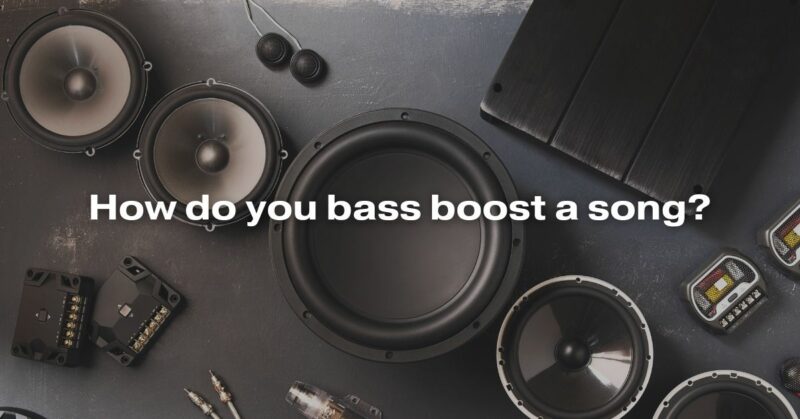Bass boosting a song is a popular audio editing technique used to enhance the low-frequency elements of music, providing a more immersive and powerful listening experience. Whether you’re a music producer looking to give your tracks that extra punch or simply a music enthusiast wanting to enjoy your favorite songs with a deeper bass presence, this comprehensive guide will walk you through the various methods and tools available for bass boosting.
Understanding Bass Frequencies
Before delving into the techniques for bass boosting, it’s essential to understand the fundamentals of bass frequencies. In music, bass typically refers to frequencies in the range of 20 Hz to 200 Hz, although this range can vary depending on the genre and style of the song. These low-frequency elements provide the foundation and groove to a track, making them vital for creating a rich and full sound.
Methods for Bass Boosting
There are several methods you can use to boost the bass in a song, ranging from simple equalization adjustments to more advanced audio processing techniques. Here, we’ll explore some of the most common methods:
- Equalization (EQ):
- Using an equalizer is the most straightforward way to boost the bass in a song. Most audio editing software, like Adobe Audition, Ableton Live, or even free options like Audacity, provide built-in EQ tools.
- Locate the low-frequency band or bands (usually labeled as “Bass,” “Low,” or “Low-Mid”) and increase their gain to boost the bass. Be cautious not to overdo it, as excessive boosting can lead to distortion.
- Bass Boosting Plugins:
- Dedicated bass-enhancing plugins are available for various digital audio workstations (DAWs). These plugins often offer more control and precision than standard EQ.
- Popular bass boosting plugins include Waves MaxxBass, iZotope Ozone, and FabFilter Pro-Q.
- Subwoofer or Bass-Boosted Headphones:
- Hardware solutions like subwoofers or bass-boosted headphones can provide a more immersive listening experience by physically enhancing low frequencies.
- These options are ideal for enjoying bass-heavy music but may not be suitable for production purposes.
- Bass-Boosted Equalizer Apps:
- For casual listening on your mobile device, you can use bass-boosted equalizer apps to enhance the bass response of your music.
- Apps like Equalizer FX, Poweramp, and Bass Booster are available for Android and iOS.
- Mastering and Compression:
- During the mastering process, audio engineers use compression and limiting techniques to balance and enhance the overall sound, including the bass.
- While this is typically done by professionals, you can explore mastering plugins or seek the assistance of a mastering engineer.
- Remixing and Layering:
- If you’re a music producer, you can remix or re-create a song to emphasize the bass elements.
- Layering additional bass sounds, such as sub-bass synths or bass guitar, can also boost the low-end.
Best Practices for Bass Boosting
When boosting the bass in a song, it’s essential to exercise caution to avoid undesirable results like distortion or an imbalanced mix. Here are some best practices to keep in mind:
- Listen Cautiously: Gradually increase the bass levels while listening to the song to ensure it doesn’t become overpowering or distorted.
- Use High-Quality Equipment: To experience the full impact of bass boosting, invest in high-quality headphones or speakers that can accurately reproduce low frequencies.
- Avoid Clipping: Be mindful of clipping, which occurs when the audio signal exceeds its maximum level, leading to distortion. Use a limiter or compressor to control peaks if necessary.
- Balance the Mix: Ensure that the boosted bass doesn’t drown out other elements of the song. The goal is to enhance, not overpower.
Conclusion
Bass boosting a song can significantly enhance the listening experience, whether you’re a music producer looking to create powerful tracks or an avid music lover wanting to enjoy your favorite songs with more depth and impact. By understanding the fundamentals of bass frequencies and employing the appropriate methods and tools, you can achieve the desired bass-boosted result while maintaining audio quality and balance. Experimentation and practice are key to mastering this audio editing technique, so don’t be afraid to explore and fine-tune your skills for optimal results.


